|
Chapter
Six
By
the 1940s, the United States was becoming the arsenal of Europe. Adolph
Hitler and Germany were at war with England and had taken France.
President Franklin Roosevelt had signed the Lend Lease Act that was
passed by Congress and millions of tons of supplies were being shipped
to Great Britain.
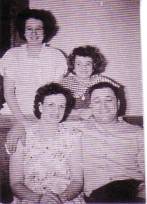 In the Carrocci family, Peter was working in the
steel mill in Beach Bottom, West Virginia. All his children were living
at home on Adams Street except Benny. Benny
was driving a city bus in Steubenville. He was living in Mingo Jct. with
his wife, Lucy Taravella, and two daughters Roseanne and Nancy.
Roseanne was born January 18th, 1938 and Nancy on March 25th,
1941.
In this picture are Lucy and Benny seated and Roseanna on the
left with Nancy in the back. In the Carrocci family, Peter was working in the
steel mill in Beach Bottom, West Virginia. All his children were living
at home on Adams Street except Benny. Benny
was driving a city bus in Steubenville. He was living in Mingo Jct. with
his wife, Lucy Taravella, and two daughters Roseanne and Nancy.
Roseanne was born January 18th, 1938 and Nancy on March 25th,
1941.
In this picture are Lucy and Benny seated and Roseanna on the
left with Nancy in the back.
Benny never spent any time in the military. He was
exempt from the draft after the United State’s entry into WWII,
because he was married with two children.
I
have many fond memories of the Benny Carroccis living in Mingo Jct. In
the early 40s I would spend weekends with them, playing with Roseanne
and Nancy.
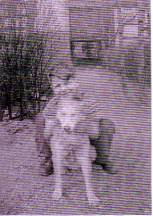 Here I am with another one of our mutts. This one was Princey. He
looks like a coyote.
Here I am with another one of our mutts. This one was Princey. He
looks like a coyote.
Lucy’s
mother and father lived a short distance away from Benny and Lucy and we
spent many afternoons there having lunch. I remember one time in
particular when Mrs. Taravella was serving some collard-like greens,
which in dialect are called minesta.
Well, I wasn’t going to have any part of those sour tasting greens and
turned up my nose. Mrs. Taravella said to me, “Mangi
la minesta o porto la finestra.” I used to understand lot more of
that old dialect than I would let on, and as the story goes, I got up
from the table, when to the window and looked out. It seemed like a long
way down, so I went back to the table, sat down and ate the minesta.
What Mrs. Taravella said was “eat the greens or I’ll throw you out
of the window.” It’s a story I heard many, many times over the
years.
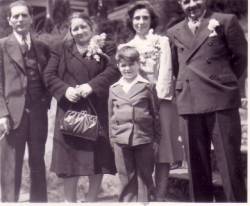 Mary Basil got married in the early 40s. In this
picture there is her new husband, Carl Patron of Canton, Ohio, on the
right. Mary is standing next to him. Anna is next and on the left was
our boarder, Angelo Carpino. That’s me standing in front. Mary Basil got married in the early 40s. In this
picture there is her new husband, Carl Patron of Canton, Ohio, on the
right. Mary is standing next to him. Anna is next and on the left was
our boarder, Angelo Carpino. That’s me standing in front.
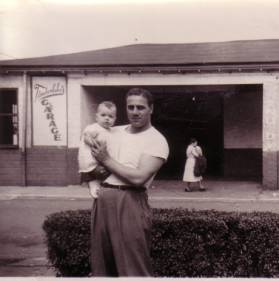
Mary and Carl Patron moved to Canton where Carl worked for the
Pennsylvania Railroad as a mechanic Carl had a daughter, Isabel, by a
previous marriage. Mary gave birth to Carl Patron Jr. in about 1945.
Joe,
shown here in a 1949 photo with his daughter Candy, had graduated from
Catholic Central High School after having played football. He soon began
working at the Pittsburg-Wheeling Steel Mill in Steubenville as a
laborer. Joe said he worked like an animal during this time. I can
remember him eating a dozen eggs, bacon and several pieces of toasted
homemade bread before heading off to work. He would also take a
half-dozen big sandwiches for his lunch. One can just imagine the
calories he must have burned up during his work shift.
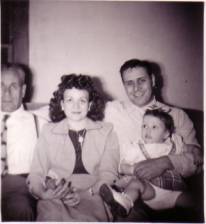 Joe married Delores Montibello on July 17, 1943 at St.
Anthony’s Church in Steubenville. Delores, or Dodo as she was
nicknamed, is shown here with Peter Carrocci, Joe and Candice.
Joe married Delores Montibello on July 17, 1943 at St.
Anthony’s Church in Steubenville. Delores, or Dodo as she was
nicknamed, is shown here with Peter Carrocci, Joe and Candice.
Joseph
Anthony served in the U.S. Navy during the war, but he never told me
much about his experiences. I do know that he injured his back while in
the Navy and received a medical discharge. He returned to work at the
Pittsburg-Wheeling Steel Company until his retirement. Joe had worked
his way up to the top job at the mill, a roller in the 80-inch mill. I
remember him telling me one time that he was the first Italian-American
to get a top job: they were usually reserved for men of English descent.
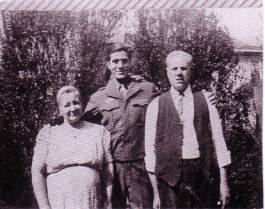 Julius Carrocci went into the Army Air Corps shortly
after the start of the Second World War. Julius Carrocci went into the Army Air Corps shortly
after the start of the Second World War.
He
is shown here in a picture with Anna and Peter taken when he was home on
leave. Julie was stationed in Gainesville, Florida where he was trained
as a military policeman.
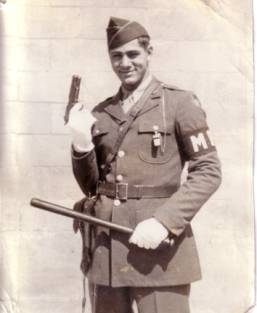
Julie
was stationed in the Pacific Theater during the war, more specifically
on the conquered Japanese island of Okinawa. He told me once that he had
one detail where he had to guard a garbage truck on its way to a dump.
He said there was a 50-caliber machine gun mounted on the top of the cab
of the big truck. It seems Japanese civilians were so hungry that they
would scour through the dump looking for food. It was a pitiful
situation.
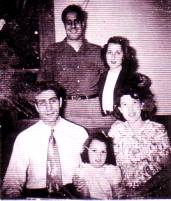 Julie
married Virginia Scott of Shadyside, Ohio. Virginia was born July 30th,
1924. Their first daughter, Signa Jean, was born January 15th,
1946. After his hitch in the service, Julius went to work at Wheeling-Pittsburg
Steel Company in Steubenville as a machinist. Julie
married Virginia Scott of Shadyside, Ohio. Virginia was born July 30th,
1924. Their first daughter, Signa Jean, was born January 15th,
1946. After his hitch in the service, Julius went to work at Wheeling-Pittsburg
Steel Company in Steubenville as a machinist.
Virginia, baby Signa Jean and Julie lived at the
family home on Adams Street for a short time. Eventually, they bought a
lot in Wintersville, Ohio and built a home. In the picture above are
Julie, Signa and Virginia seated and brother Larry with Rosie Bevalaqua
standing behind. Rosie Bevalaqua was a good friend of Theresa Ann
Carrocci.
About
that house in Wintersville, Julie first built the basement in which he
lived for a time. Then his brother Bugs would come out on his days off
and lay the bricks for the upper floor. In driving by the house one day,
Bugs said that he laid every brick in the house.
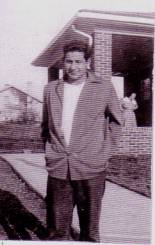 Dominic James, shown here, spent the early 40s going to school
and hanging out with his buddies. Bugs, as he was known all over town,
quit school in the 10th grade and got a job at the Nehi
Bottling Company in Steubenville. Things were great until Anna Carrocci
found out. It seems a teacher asked mama why Bugs wasn’t in school.
She packed his clothes and left them on the back porch for when he came
home. It wasn’t long before he sweet-talked her into letting him back
in the house, even if he did have to start paying rent.
Dominic James, shown here, spent the early 40s going to school
and hanging out with his buddies. Bugs, as he was known all over town,
quit school in the 10th grade and got a job at the Nehi
Bottling Company in Steubenville. Things were great until Anna Carrocci
found out. It seems a teacher asked mama why Bugs wasn’t in school.
She packed his clothes and left them on the back porch for when he came
home. It wasn’t long before he sweet-talked her into letting him back
in the house, even if he did have to start paying rent.
With
the war going full bore in 1943, Bugs soon got a better job at the
Timpkin Roller Bearing Company in Canton, Ohio, where he lived with
sister Mary. Bugs said he worked long hours but made good money, some of
which he sent home to the folks. That job, however, didn’t last very
long.
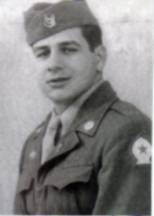 Bugs was drafted into the Army for the duration of the war in
1945. He went to Gainesville, Florida after basic training and learned
to be a Military Policeman, just as his brother Julie before him. Bugs
even stayed with the same family that Julius stayed with in Gainesville.
Bugs was drafted into the Army for the duration of the war in
1945. He went to Gainesville, Florida after basic training and learned
to be a Military Policeman, just as his brother Julie before him. Bugs
even stayed with the same family that Julius stayed with in Gainesville.
The
war ended before Bugs was sent overseas. He was stationed at the army
base in Lavorno, Italy. While
in Italy, Bugs managed to see quite a few sights, such as Lido
Island, a resort area near Venice.
He also made stops in Cortino,
Italy and Geneva, Switzerland.
He always talked fondly of this part of his service life and he was
considered a World War Two veteran.
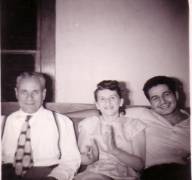 Back in Steubenville in 1948, Bugs went to work at the Rex Cigar
Store as a dealer. He dealt the wheel, blackjack, poker and craps. It
wasn’t long before he went to work for Jimmie “The Greek” Snyder.
Bugs had a knack for making odds, a talent needed by The Greek.
Back in Steubenville in 1948, Bugs went to work at the Rex Cigar
Store as a dealer. He dealt the wheel, blackjack, poker and craps. It
wasn’t long before he went to work for Jimmie “The Greek” Snyder.
Bugs had a knack for making odds, a talent needed by The Greek.
That’s
when he met Helen Mininni, shown here sitting between Bugs and his
father. It was her father who made a deal with Bugs. Frank Mininni told
Bugs could marry Helen if he quit the gambling business. He did and they
did on March 4th 1950.
Bugs
went to work for a construction company for awhile and then got on at
the Steel Mill in Steubenville. While he was working for the
construction company his godfather Jimmy Tripoti asked why he quit
working in the gambling joint that Tripoti controlled. He wanted Bugs to
go back to work for him. Bugs told him no and didn’t tell him why.
Jimmy Tripoti wouldn’t talk to Bugs for years. One day he found out
why, that Bugs had made a promise to Helen’s father, and Compare Jimmy
hugged Bugs and praised him for being an honorable man by keeping his
promise.
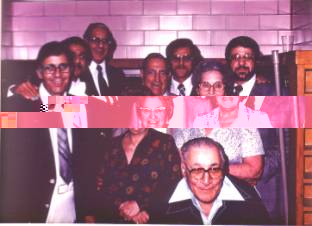 This
is a picture of Jimmy Tripoti taken in August of 1978.From left to right
it shows Joe Carrocci, Bugs, brother Larry behind, cousin Larry Carrocci
in the back middle, I’m standing behind Aunt Selma. In the center are
Jimmy and May Tripoti. Aunt Selma is on the right and Benny Carrocci in
front. This
is a picture of Jimmy Tripoti taken in August of 1978.From left to right
it shows Joe Carrocci, Bugs, brother Larry behind, cousin Larry Carrocci
in the back middle, I’m standing behind Aunt Selma. In the center are
Jimmy and May Tripoti. Aunt Selma is on the right and Benny Carrocci in
front.
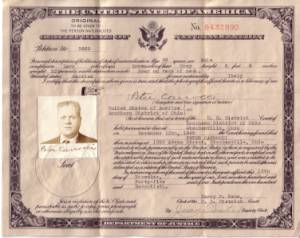
On
November 13, 1945 Peter Carrocci became Naturalized Citizen of the
United States. This was something of which he was very proud. Just think
of the accomplishment. He came to a new country, learned to read and
write the language and made a success of himself by all the standards of
his former country. Yes, there were a lot of bumps in the road and a lot
more were to come, but for the moment he certainly could call himself a
success.
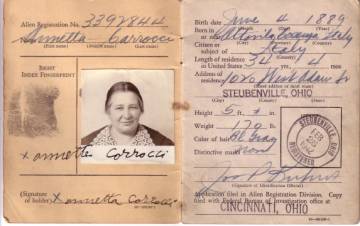 Anna
never did become a U.S. citizen. She had to register as an alien, which
she did on this occasion on February 26. 1942. Being a registered alien
during wartime meant certain restrictions. They limited travel, carrying
firearms, ammunition, radios, and cameras and had to give written notice
of change of name, residence, or place of employment. Anna didn’t
travel very much, maybe a trip to Canton, Ohio to visit Mary or to Mingo
to visit Benny, Lucy and the girls. Mostly she stayed in Steubenville
and visited old friends close by. She would walk down Adams Street to
the little store on the corner of 9th and Adams. Sometimes
she would walk down to 8th street to visit friends. Anna
never did become a U.S. citizen. She had to register as an alien, which
she did on this occasion on February 26. 1942. Being a registered alien
during wartime meant certain restrictions. They limited travel, carrying
firearms, ammunition, radios, and cameras and had to give written notice
of change of name, residence, or place of employment. Anna didn’t
travel very much, maybe a trip to Canton, Ohio to visit Mary or to Mingo
to visit Benny, Lucy and the girls. Mostly she stayed in Steubenville
and visited old friends close by. She would walk down Adams Street to
the little store on the corner of 9th and Adams. Sometimes
she would walk down to 8th street to visit friends.
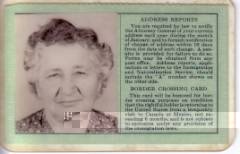 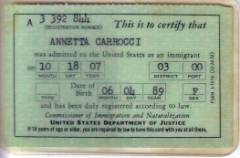
The one thing that being a registered alien allowed was for Anna
to have a green card, and here it is. The green card proved that she was
a legal resident of the United States.
It
would also allow her to work, if she had to. The day would come when she
did have to go to work outside the home, but for the time being Anna was
happy with her status in the U.S.
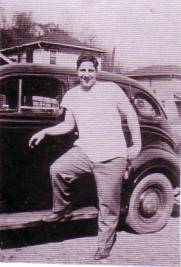 Larry Martin was a typical Carrocci boy. Lots of rough and tumble
in the neighborhood. I can remember a game he used to play with his
buddies. It was called “strong horse”. One guy would stand up
against a power pole and several others would bend over forming a horse.
The other guys would start jumping on their backs to see how many they
could hold. The team which held the most guys won.
Larry Martin was a typical Carrocci boy. Lots of rough and tumble
in the neighborhood. I can remember a game he used to play with his
buddies. It was called “strong horse”. One guy would stand up
against a power pole and several others would bend over forming a horse.
The other guys would start jumping on their backs to see how many they
could hold. The team which held the most guys won.
Lala,
as Larry was called in the family, played football for Steubenville High
School. He did very well for Big Red. After graduating from high school
Larry enlisted in the Navy and went to boot camp at the Great Lakes
Naval Training Center.
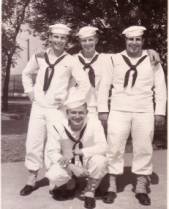 Here’s our sailor in the picture at right with three
of his buddies. There’s no doubt who the Carrocci is in this picture.
After his stint in the Navy, Larry came back to Steubenville and got a
job at the mill working 3 to 11 pm. He also started going to school
during the mornings. Here’s our sailor in the picture at right with three
of his buddies. There’s no doubt who the Carrocci is in this picture.
After his stint in the Navy, Larry came back to Steubenville and got a
job at the mill working 3 to 11 pm. He also started going to school
during the mornings.
During this time, Bugs and Larry would share a room with their
little brother, me. The big boys shared a double bed while I had a
smaller twin bed. In those days there was just an exposed set of springs
with a mattress on top. Bugs was the smaller of the two and always
complained because he would roll into the middle of the bed and Larry
would roll on top of him.
Theresa
and I called Larry “The Volcano”, during the time he was working and
going to school. Larry would study in the dining room and if we made any
noise he would erupt. I can still hear him hollering at us to keep
quiet. It’s hard to keep a couple of teenagers from making noise.
Brother
Larry was a good student as well as a good worker. He left Steubenville
and went to Finn College in Cleveland for awhile. He eventually ended up
at Ohio State University, where he graduated in 1955 with a degree in
industrial engineering. He was the only one of the Peter Carrocci
children to get a full college education. We were all very proud of him.
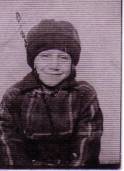 Theresa Ann managed very well growing up in a household full of
boys. She was a helping hand to both Anna and Mary, doing laundry,
assisting in the changing of beds, and setting tables and doing dishes.
She, like the rest of the family had chores to do.
Theresa Ann managed very well growing up in a household full of
boys. She was a helping hand to both Anna and Mary, doing laundry,
assisting in the changing of beds, and setting tables and doing dishes.
She, like the rest of the family had chores to do.
She always seemed to have a circle of girlfriends
around her and was busy with school and after school activities. She was
especially attentive to me. She always watched out for me until the day
I convinced her that she could fly and talked her into jumping off of a
shed roof in the back yard. After her broken arm healed she was less
inclined to take such good care of me. In fact, she would tie me to a
tree or a power pole to keep me from chasing after her.
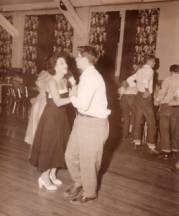 One
of the things she did do with me was dance.
We used to go to Washington Elementary School at the bottom of
Adams Street for after school record hops. We both became good dancers
and kept up the practice into our teens. The move to Tucson changed
everything, and that’s the next chapter. For sure, there was a lot
less dancing and lot more work. One
of the things she did do with me was dance.
We used to go to Washington Elementary School at the bottom of
Adams Street for after school record hops. We both became good dancers
and kept up the practice into our teens. The move to Tucson changed
everything, and that’s the next chapter. For sure, there was a lot
less dancing and lot more work.
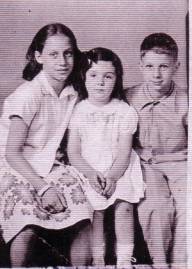
Being the last of the Carrocci children, I had a lot of older
people around me telling me what to do. An older brother getting me to
go out and hunt for cigarette butts so he could get the tobacco out and
roll new cigarettes. That was for brother Bugs and his buddies who had a
small clubhouse in the Scipio garage next door. They used to let me hang
around once in awhile and I thought that was cool. The picture at right
is with Theresa and Isabel Patron.
There was a whole neighborhood to run around in.
Friends on Edgar Avenue, which was halfway down the Adams Street hill,
and singing in the Washington Elementary School chorus.
One of the best times was playing ball. The kids
would take a rolled up newspaper and use it as a football. We would play
tackle ball on the street. We’d also play baseball in the lot at the
Colored Recreation Center. All the baseballs we used were wrapped with
black electricians tape. No one could afford a new baseball.
One
of the dramatic things that happened in the 1940s was my rebellion with
the Jehovah’s Witness religion. Peter Carrocci, while not exactly a
religious fanatic, was very adamant about making sure I attended all the
activities of church. This I did until I was about eight years old. By
then, I had joined the Boy Scouts at St. Anthony’s Catholic Church
along with a few of my friends and Father Rector, the parish priest at
the time, wanted me to be an altar boy. That sounded like a good idea to
me and I told pop that I didn’t want to go to the Jehovah’s Witness
services any longer.
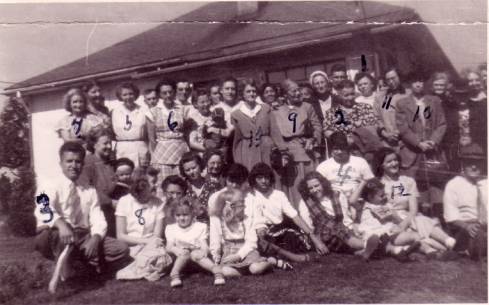 This is Peter Carrocci’s Jehovah’s Witness
group. Anna is number two. I’m number four. It is one the last times I
was with the group. This is Peter Carrocci’s Jehovah’s Witness
group. Anna is number two. I’m number four. It is one the last times I
was with the group.
The battle between father and son was joined. Peter
would drag me to the meetings, clutching my wrist in one hand and his
books in the other. If no one was going in the door at the same time,
Pop would sometimes let go of my wrist to open the door. I would run
across the street and climb over a chain-link fence to get away. I would
then turn around and look at pop, knowing that I would later get a
severe beating when he next caught up to me. This went on for several
weeks until Peter finally gave up.
There
was a lot of animosity between father and son; a hatred that didn’t go
away for many years. We were two very stubborn people. One tough man who
came to a new country, learned a new language, taught himself to read
and write and who made a success of himself. And at the time I was one
tough street kid who was used to harsh treatment both at home and in the
neighborhood. Change, however, was just around the corner.
<<BACK
HOME NEXT>> |





















